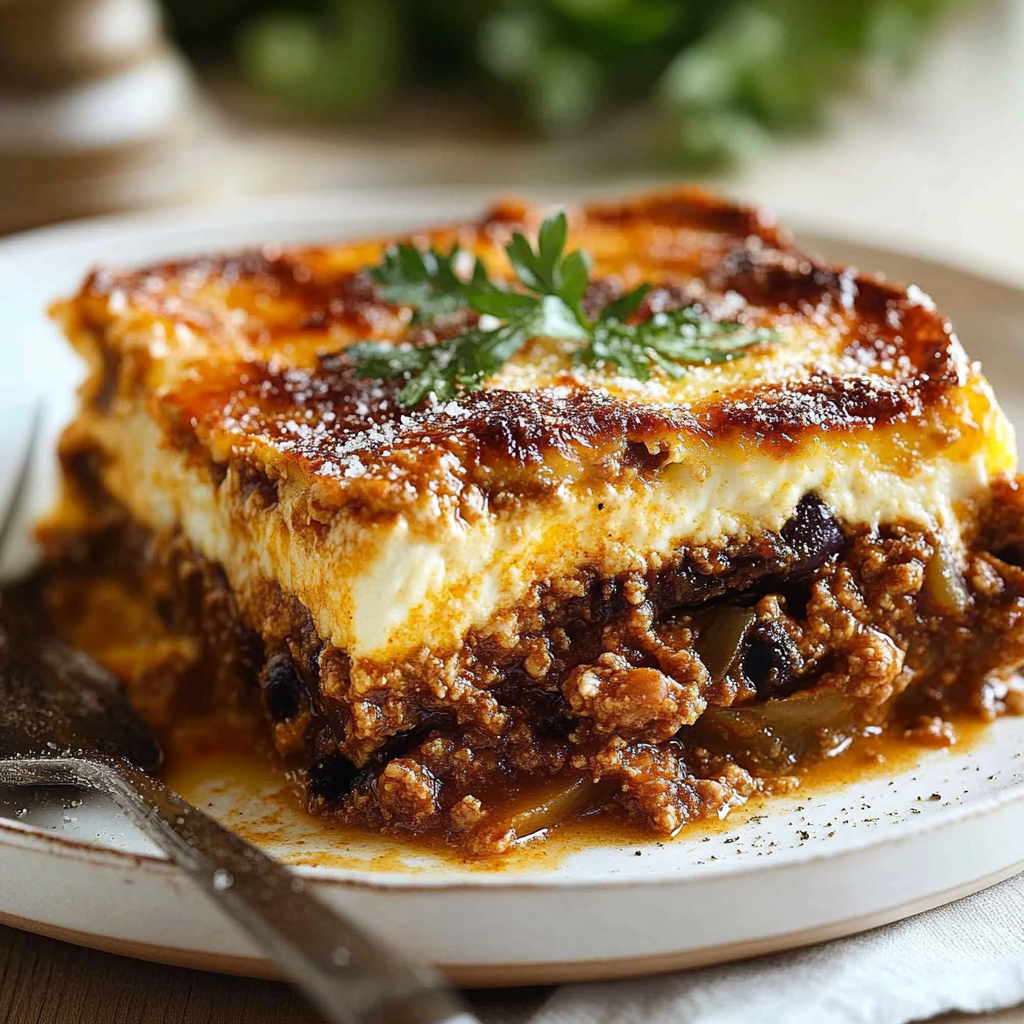Have you ever tasted a dish that transports you straight to another place? Imagine sinking your fork into a steaming slice of Greek moussaka, where layers of tender eggplant smothered in rich meat sauce meet a velvety béchamel topping. This iconic dish not only captures the essence of Mediterranean flavors but also evokes memories of sun-soaked days spent in quaint tavernas overlooking azure shores.
Greek moussaka is more than just food; it’s an experience filled with warmth and comfort. Each bite reveals a medley of spices that dance on your palate, while the creamy texture offers a perfect balance to the savory layers beneath. Whether celebrating a holiday or enjoying a cozy family dinner, serving this classic dish is bound to impress your guests and create lasting memories.
Why You’ll Love This Greek Moussaka
- Delicious Layers: The combination of roasted eggplant, seasoned meat sauce, and creamy béchamel creates an explosion of flavors in every bite. Each layer complements the others perfectly, making every forkful irresistible.
- Perfect for Entertaining: Impress your friends and family by serving this stunning dish at gatherings or special occasions. Its elegant presentation will make you the star of any dinner party.
- Meal Prep Friendly: Moussaka can be prepared ahead of time and stored in the refrigerator or freezer until you’re ready to bake it. This makes it an excellent choice for busy weeknights or meal planning.
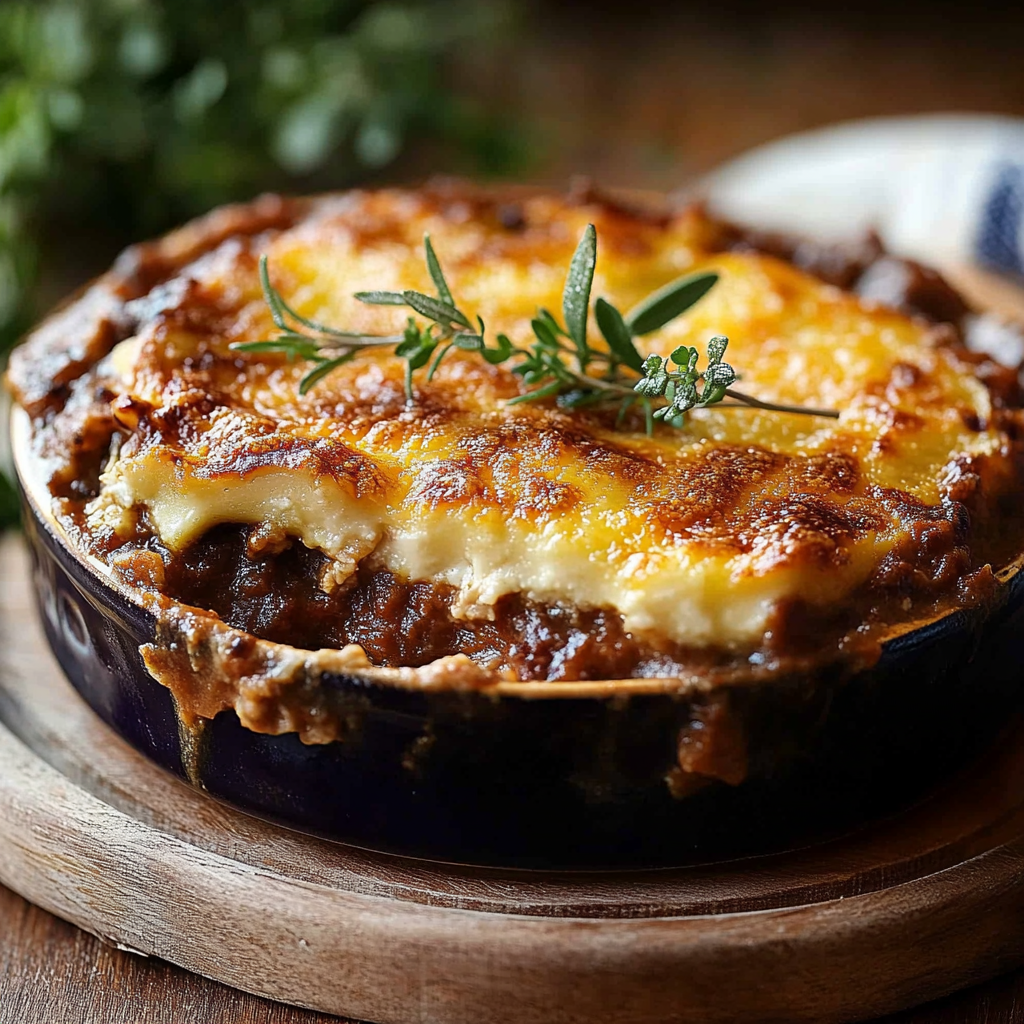
Ingredients for Greek Moussaka
Here’s what you’ll need to make this delicious dish:
- Eggplants: Choose firm, fresh eggplants for roasting; they add depth and texture to the dish.
- Ground Beef or Lamb: Use high-quality ground meat for the best flavor; lamb adds a unique richness typical in traditional recipes.
- Onion: A finely chopped onion provides a savory base for the meat sauce; sauté until golden for enhanced sweetness.
- Garlic: Fresh minced garlic elevates the flavor profile; use about four cloves for a fragrant touch.
- Canned Tomatoes: Opt for crushed tomatoes to add moisture and acidity to the meat sauce; they bring everything together beautifully.
For the Sauce:
- Béchamel Sauce Ingredients: You’ll need butter, flour, milk, nutmeg, and eggs to create this rich white sauce that tops your moussaka.
The full ingredients list, including measurements, is provided in the recipe card directly below.
How to Make Greek Moussaka
Follow these simple steps to prepare this delicious dish:
Step 1: Prepare the Eggplant
Slice the eggplants into thick rounds and sprinkle them generously with salt. Let them sit for about 30 minutes to draw out excess moisture and bitterness.
Step 2: Roast the Eggplant
Preheat your oven to 400°F (200°C). Rinse off the salt from the eggplants and pat them dry with paper towels. Arrange them on a baking sheet lined with parchment paper and drizzle with olive oil. Roast for about 25-30 minutes until golden brown.
Step 3: Cook the Meat Sauce
In a large skillet over medium heat, add some olive oil and sauté chopped onions until translucent. Add minced garlic followed by ground beef or lamb. Cook until browned, then stir in crushed tomatoes along with salt, pepper, cinnamon, and other spices as desired. Simmer for about 20 minutes.
Step 4: Prepare Béchamel Sauce
In another saucepan over low heat, melt butter before adding flour to create a roux. Gradually whisk in milk until thickened; remove from heat before stirring in nutmeg and beaten eggs for richness.
Step 5: Assemble Your Moussaka
In a greased baking dish, layer half of your roasted eggplant slices on the bottom. Spread half of the meat sauce over it followed by another layer of eggplant and finish with remaining meat sauce. Pour béchamel sauce on top evenly.
Step 6: Bake
Bake in preheated oven at 350°F (175°C) for about 45-50 minutes until golden brown on top. Let it cool slightly before slicing into portions.
Transfer to plates and drizzle with olive oil as a perfect finishing touch.
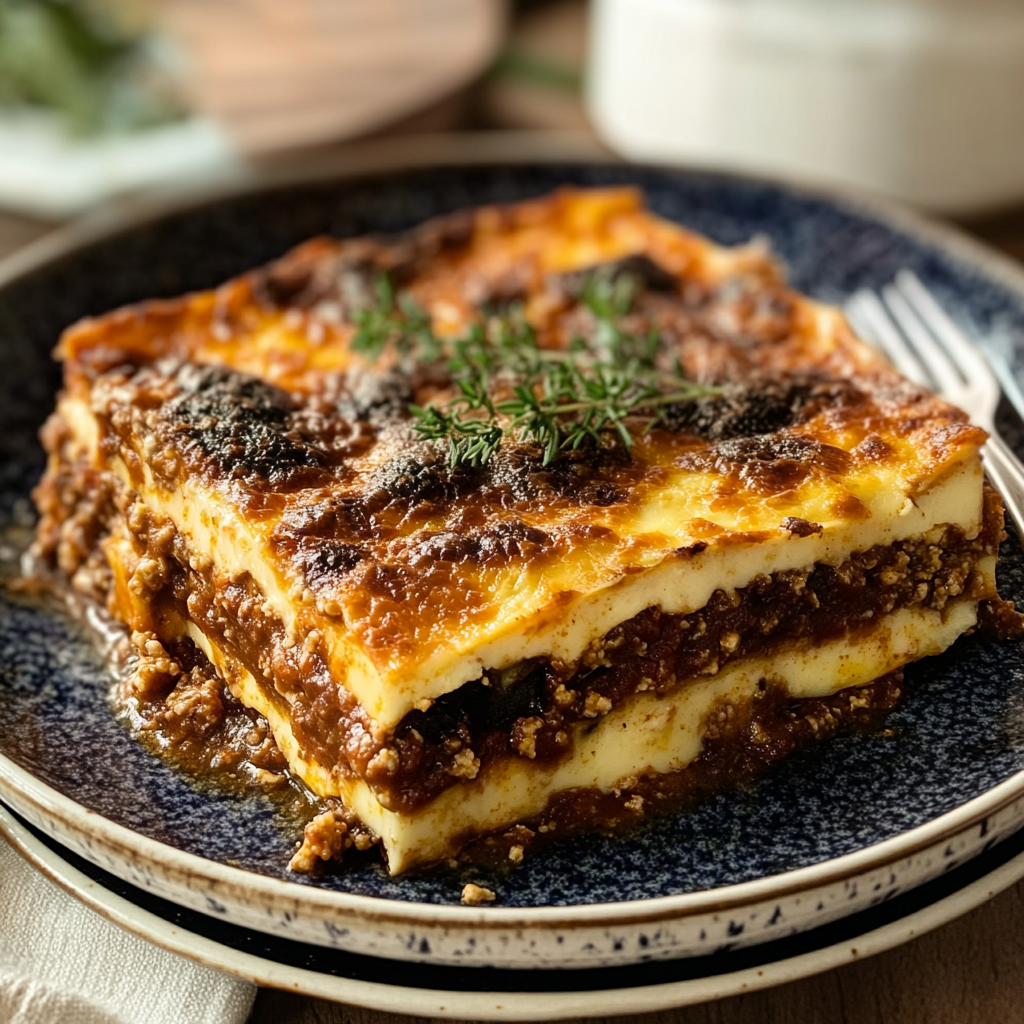
Tips and Tricks
Here are some helpful tips to ensure the best results for your dish:
- Choose Quality Ingredients: Fresh ingredients greatly enhance flavor; focus on selecting ripe vegetables and quality meats.
- Let It Rest: Allowing your moussaka to rest after baking helps set its layers better; aim for at least half an hour before serving.
- Experiment With Spices: Don’t hesitate to adjust spices according to personal taste preferences; oregano or allspice can add nice notes.
Mistakes to avoid
- Not salting the eggplant: One of the most common mistakes when making Greek Moussaka is skipping the step of salting the eggplant. Salting helps draw out moisture and bitterness from the eggplant, resulting in a more flavorful dish. If you don’t salt the eggplant, it can turn mushy during cooking and negatively impact the texture of your moussaka. To properly salt, slice the eggplant and sprinkle it generously with salt. Let it sit for about 30 minutes before rinsing and patting it dry.
- Rushing the béchamel sauce: A creamy béchamel sauce is essential for a delicious Greek Moussaka. Many home cooks try to rush this process, leading to a lumpy or undercooked sauce. Take your time when making the béchamel by slowly whisking the flour into melted butter and gradually adding milk while stirring constantly. This will create a smooth, velvety texture that perfectly complements the layers of your moussaka.
- Overloading on spices: While spices play an important role in enhancing flavor, overloading your Greek Moussaka with too many spices can overwhelm the dish. Stick to traditional flavors like cinnamon, nutmeg, and allspice to maintain authenticity. Too many spices can mask the natural flavors of ingredients like meat and vegetables. Use them sparingly for balanced seasoning that highlights each layer of flavor instead.
- Skipping the resting time: After baking your Greek Moussaka, it’s tempting to dig in right away. However, allowing it to rest for at least 30 minutes before serving is crucial. This resting period lets the layers settle and makes slicing easier without falling apart. It also enhances the flavors as they continue to meld together while cooling slightly.
- Using low-quality ingredients: The quality of ingredients directly influences your moussaka’s final taste and texture. Avoid using low-quality meat or canned tomatoes as they can lead to an inferior dish. Opt for fresh vegetables, high-quality ground meat, and ripe tomatoes whenever possible. Investing in good ingredients ensures that your Greek Moussaka is rich in flavor and worth every bite.
Serving Suggestions
This Greek Moussaka is versatile and pairs wonderfully with:
- Greek Salad: A fresh Greek salad complements the rich flavors of Moussaka. The crisp vegetables and tangy feta add a refreshing contrast.
- Pita Bread: Soft pita bread makes for an excellent side. Use it to scoop up the Moussaka and enjoy every bite with ease.
- Yogurt Sauce: A dollop of tzatziki or plain yogurt enhances the dish’s flavor, providing a cool and creamy element that balances the warmth of the Moussaka.
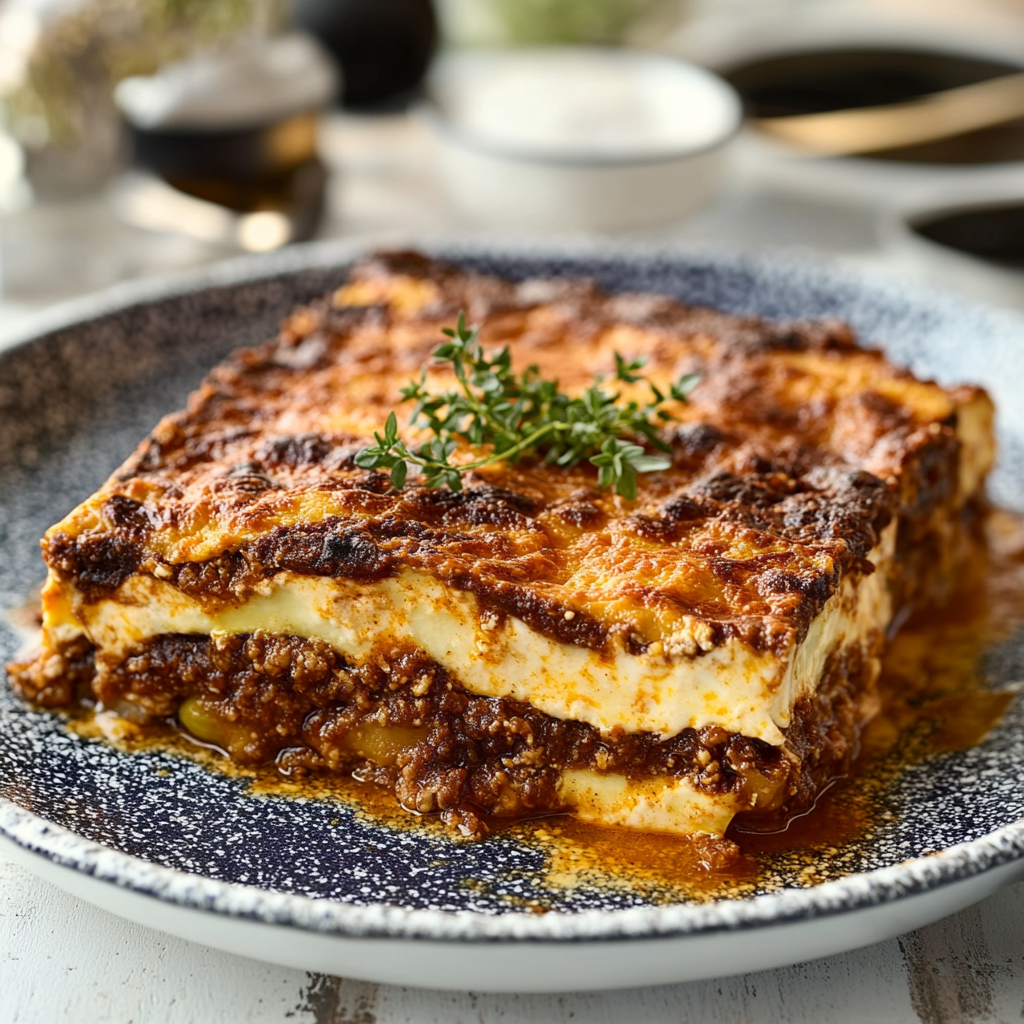
FAQs
What is Greek Moussaka?
Greek Moussaka is a traditional dish made from layers of eggplant, spiced ground meat, and béchamel sauce. This comforting casserole hails from Greece and often features potatoes, although variations exist. Each layer contributes to its rich texture and flavor profile. The combination of spices like cinnamon and nutmeg lends a unique warmth, making it a favorite for gatherings and family dinners.
How do I store leftovers of Greek Moussaka?
To store leftovers of Greek Moussaka, allow it to cool completely before transferring it to an airtight container. Refrigerate it for up to three days. You can also freeze portions for future meals. Just make sure to wrap it tightly in plastic wrap or foil before placing it in a freezer-safe container. When ready to eat, thaw overnight in the refrigerator and reheat in the oven for optimal texture.
Can I make Greek Moussaka vegetarian?
Yes! You can easily adapt Greek Moussaka into a vegetarian dish by substituting the ground meat with lentils or mushrooms. Layer in additional vegetables like zucchini or bell peppers for added flavor and nutrition. Use a plant-based béchamel sauce made from almond milk or other non-dairy alternatives to keep it vegetarian-friendly without sacrificing taste.
What are some variations of Greek Moussaka?
Greek Moussaka has several variations depending on regional ingredients and personal preferences. Some people include layers of potatoes at the bottom, while others prefer just eggplant. You might find versions that use different meats such as lamb or beef, or even seafood in coastal regions. The spices can also vary; some recipes emphasize herbs like oregano while others focus on warming spices such as allspice.
Conclusion for Greek Moussaka
In summary, Greek Moussaka is a beloved Mediterranean dish that offers layers of flavor through its unique combination of eggplant, spiced meat, and creamy béchamel sauce. Perfect for family gatherings or special occasions, this hearty meal satisfies all appetites. With simple serving suggestions like Greek salad or tzatziki sauce, you can elevate your dining experience even further. Whether you enjoy traditional recipes or explore vegetarian adaptations, making Greek Moussaka at home will surely impress your family and friends alike.
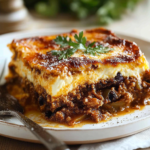
Greek Moussaka
- Total Time: 1 hour 20 minutes
- Yield: Serves 6
Description
Greek Moussaka is a heartwarming Mediterranean dish that delights the senses with its rich layers of flavor. This traditional casserole features tender roasted eggplant, spiced ground meat, and a creamy béchamel sauce that ties everything together. Each slice offers a harmonious blend of textures and tastes, evoking memories of sun-soaked days in Greece. Perfect for family gatherings or special occasions, this comforting dish promises to impress your guests and create lasting memories around the dinner table.
Ingredients
- 2 large eggplants
- 1 lb (450g) ground beef or lamb
- 1 onion, finely chopped
- 4 cloves garlic, minced
- 1 can (14 oz) crushed tomatoes
- 3 cups milk
- ½ cup butter
- ½ cup flour
- Nutmeg, salt, and pepper to taste
Instructions
- Slice eggplants into rounds, sprinkle with salt, and let sit for 30 minutes. Rinse and pat dry.
- Preheat oven to 400°F (200°C). Roast eggplants on a lined baking sheet for about 25-30 minutes until golden brown.
- In a skillet, sauté onions in olive oil until translucent. Add garlic and ground meat; cook until browned. Stir in crushed tomatoes and spices; simmer for 20 minutes.
- For béchamel sauce: Melt butter in a saucepan, add flour to make a roux, then gradually whisk in milk until thickened. Stir in nutmeg.
- Assemble: Layer half of the eggplant in a greased baking dish, followed by half of the meat sauce, another layer of eggplant, remaining meat sauce, then pour béchamel on top.
- Bake at 350°F (175°C) for 45-50 minutes until golden brown.
- Prep Time: 30 minutes
- Cook Time: 50 minutes
- Category: Main
- Method: Baking
- Cuisine: Greek
Nutrition
- Serving Size: 1 serving
- Calories: 350
- Sugar: 6g
- Sodium: 800mg
- Fat: 21g
- Saturated Fat: 10g
- Unsaturated Fat: 9g
- Trans Fat: 0g
- Carbohydrates: 28g
- Fiber: 5g
- Protein: 15g
- Cholesterol: 60mg

